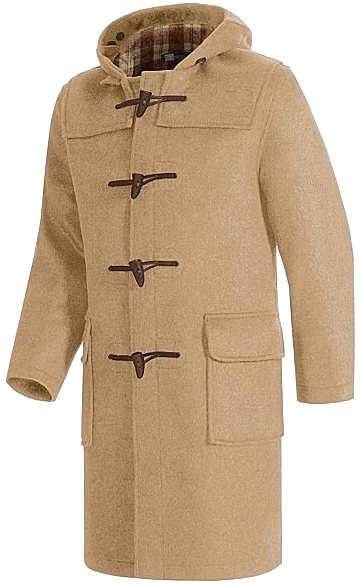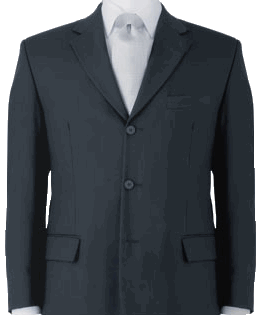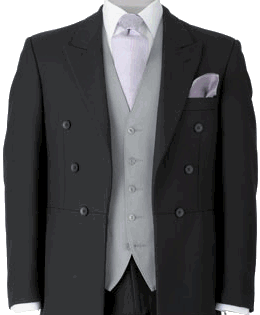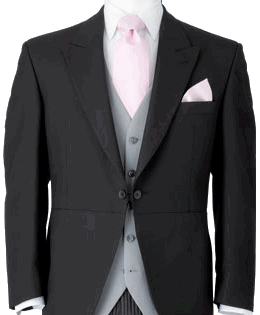

the Zipper (1914)
trenchcoat (1901)

At the end of the nineteenth century (1890s) an informal evening version of the lounge suit emerged in England, known as
a dinner jacket in British English, in a dress code referred to as black tie. When it was imported to the United States, it became
known as as the tuxedo. The dinner jacket was originally called a 'dress lounge' in England to indicate that it was a lounge suit for
evening wear. The 'dress lounge' was originally worn only for small private gatherings and white tail tie was worn for large formal
events. The 'dress lounge' slowly became more popular for larger events as an alternative to full evening dress in white tie. As
black tie grew in popularity, it has became increasingly acceptable as formalwear and today has all but replaced white tie, which
today is only seen at ultra-formal occasions. The daytime formal equivalent to white tie is morning dress, but in the United States
this too has become uncommon and the daytime semi-formal dress called the stroller is more common. The stroller is itself a form
of 'dress lounge' - a day time semi-formal lounge suit version of morning dress

the duffle coat (1890)

The lounge suit became increasingly popular through the later nineteenth century as casual town daywear until it started to become
an acceptable alternative to the morning coat as town wear in the early twentieth century. As the lounge suit became increasingly popular,
even the humblest men would have at least one suit to wear on Sunday to church as part of their "Sunday best." Victorian men who were
able to afford it would still wear a frock coat to church. The waistcoat or vest
was worn regularly with the suit until World War II but is rarely seen today

The ultimate in formalwear, the white tie and tails ensemble was, until the 1930s, the only accepted form of evening dress
for gentlemen. Black, as a colour for evening, was first worn by the 19th-century writer Edward Bulwer-Lytton, who
wanted to make the statement that he was "a blighted being". He further taunted London dandies by writing, in 1828,
that "people must be very distinguished to look well in black". The white tie's appearance, with its double-breasted tailcoat
(always worn open), starched white waistcoat, wing-collar shirt and white bow tie, has remained more or less unchanged for
more than 150 years. Today it is worn for the most formal of weddings, state occasions, banquets and other similarly grand
affairs. The variation in red is favoured by toastmasters.
Tweed (1830)

Although something similar was worn as far back as the 17th century, it wasn't until mid-Victorian times that the frock coat
became the hallmark of respectability. With its tails and straight front edges, it remained 'correct' business daywear (favoured
by the Prince of Wales and bank managers) well into the 1920s.
Today the fickle finger of fashion is pointing once again at the frock coat - seen by some as a little quirky and daring.
With its dark and sophisticated formality a frock coat provides a great backdrop for some truly audacious accessorising.

The morning suit began its life in the 19th century as a riding coat - since that is how a gentleman generally spent his mornings -
and has curved front edges that slope back at the sides, leaving the rider's knees free from flapping coat fronts. The two buttons
at the rear of the coat were to fasten the tails up out of the way when riding. Creating an ultra-flattering and slimming outline,
Moss Bros Hire's Classic morning suit with black jacket and striped trousers is the traditional dress for formal weddings. Grey
and blue coats, while less traditional than black, are becoming more popular now for weddings (particularly for the groom and
during summer) and grey is always popular at Royal Ascot. A grey waistcoat is the classic choice under a black coat, but more
adventurous dressers might well prefer one of Moss Bros Hire's many patterned or colour waistcoats.
the waistcoat (1666)
***********************
tailoring
The term "ditto suit" was also transiently used due to the matching waistcoat and trousers, these sometimes having coats more resembling
a frock coat or a morning coat. The "sack suit" is a North America derivative of the English lounge suit which looked even looser and more
casual because it lacked darts. In the nineteenth century, for more informal occasions, men still wore morning dress as a more casual
alternative to the formal frock coats then considered appropriate business and day time formalwear. The lounge suit was thus an even
more casual form of dress and was reserved solely for recreation activities
What we call the modern suit was originally a nineteenth-century English innovation in dress. Originally the term usually referred to
a lounge suit and was worn only in the country and at the seaside. At that time morning dress and frock coats were not part of a 'suit'
because they are were usually worn with non-matching striped trousers, and having matching waistcoat and trousers was originally
considered more informal
Coats with matching trousers or even waistcoat have gone in and out of fashion over the last four centuries however the modern
lounge suit coat is still derived from historical coats. Although it is hard to see the outline of the modern business suit coat in the elaborate
and brightly-coloured court dress of the seventeenth century, the basic pattern has survived for more than four hundred years with some
adjustments, despite the abandonment of wigs and knee breeches after the French Revolution, the rise of British tailoring, which used steam,
pressure, padding, and stiffening to mould woolen fabric to the body, the invention of the modern necktie in the late nineteenth century,
and the gradual disappearance of waistcoats and hats during the last fifty years
Charles, following the example of the court of Louis XIV at Versailles decreed in 1666 that at court, men were to wear a long
coat or jacket, a waistcoat (originally called a petticoat, a term which later became applied solely to women's dress), a cravat
(ancestor of the modern necktie) a wig, and breeches or trousers gathered at the knee, as well as a hat for outdoor wear
The modern suit did not appear until the mid nineteenth century, but the origins of its coat can be
traced back to the revolution in men's dress set by Charles II, king of Great Britain in the 1660s